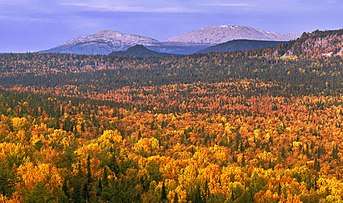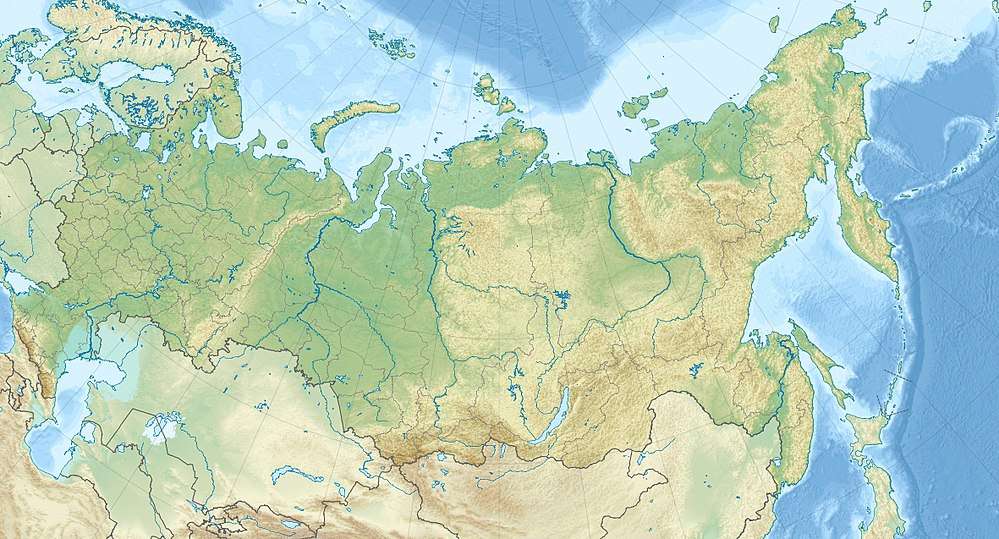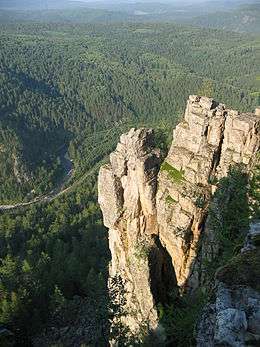South Ural Nature Reserve
South Ural Nature Reserve (Russian: Южно-Уральский заповедник) (also Yuzhno-Uralsky) is a Russian 'zapovednik' (strict nature reserve) protecting mountain taiga ecosystems in the highest part of the Southern Ural Mountains. Several mountain ranges run through the territory: Mashak, Zigalga, Nara Kumardak and Yamantau. Mt. Yamantau reaches 1,640 metres (5,380 ft), and is the highest mountain in the Southern Urals. 90% of the reserve is situated in the Beloretsky District of Bashkortostan, the remainder is in Chelyabinsk Oblast. The regional city of Ufa is about 200 km to the northwest.[1][2]
| South Ural Nature Reserve | |
|---|---|
| Russian: Южно-Уральский заповедник (Also: Yuzhno-Uralsky) | |
IUCN category Ia (strict nature reserve) | |
 Mt. Yamantau, highest point in South Ural Mountains | |
 Location of Reserve | |
| Location | Bashkortostan, and Chelyabinsk Oblast |
| Nearest city | Beloretsk |
| Coordinates | 54°20′48″N 57°53′9″E |
| Area | 252,800 hectares (624,682 acres; 976 sq mi) |
| Established | 1979 |
| Governing body | Ministry of Natural Resources and Environment (Russia) |
| Website | http://www.south-ural-reserve.ru/ |
Topography
The South Ural Reserve terrain consists of several mountain ridges (Mashak, Zigalga, Nara Kumardak and Yamantau) running in parallel from southwest to northeast, with broad inter-mountain valleys and cross-river cuts that create a lattice structure. The area was not fully glaciated, but shows evidence of local glaciation (moraine deposits) on the mountain and plateaus. All of the rivers in the territory are classified as small rivers or streams; the longest is the Small Inzer River, which is 93 km long and runs entirely within the reserve boundaries. The streams have fast currents and rocky beds. There are several small bogs in the reserve. The South Urals reserve is surrounded on all sides by forestry zones.[2][1]
The area has been heavily affected by successive waves of economic activity in the area. The region was the site of extensive iron foundries in the 1700s and 1800s, which the attendant pollution of rivers and extensive cutting of trees to feed the charcoal kilns. In the early 1900s, commercial logging expanded, and during the war several internment camps were built inside one of the borders along with a narrow gauge railroad. In the 1970s, roads, powerlines, and pipelines were laid across parts of the territory. In 1979, the reserve was established to restore and protect a large section of representative Southern Ural forest.[2]
Climate and Ecoregion
South Ural is located in the Urals montane tundra and taiga ecoregion. This ecoregion covers the Ural Mountains in a band that is narrow from west-east, but runs up most of the divide between European and Asiatic Russia. It is a meeting zones of taiga and tundra tree and plant species.[3]
The climate of the South Ural Reserve is Humid continental climate, warm summer (Köppen climate classification (Dfb)). This climate is characterized by large swings in temperature, both diurnally and seasonally, with mild summers and cold, snowy winters.[4][5] In the South Ural Reserve, average annual precipitation is 667 mm, the growing season averages 168 days, and the average frost-free period, from May 30 to mid September, averages 107 days. At the highest elevations, the precipitation rises to 1,100 mm, and the frost-free period drops to 60 days.
Flora and fauna
Forests cover 89% of the ground; they are a mix of light conifers (4 species) and deciduous (10 species, including aspen and birch). Above 1200 meters, the zone of mountain tundra is one of shrub-moss plant communities. Scientists on the reserve have recorded 700 species of vascular plants.[6]


The mammals of the reserve are forest species. Moose are common, as a black bear. 13 different predator species are present (including wolves as permanent residents), indicating significant prey that include deer and elk. 50 different mammal species have been recorded. 168 species of birds have been recorded, with 132 nesting.[6]
Ecoeducation and access
As a strict nature reserve, the South Ural Reserve is mostly closed to the general public, although scientists and those with 'environmental education' purposes can make arrangements with park management for visits. The main office is in the town of Beloretsk, 90 km away.[1]
References
- "South Ural Zapovednik (Official Site)" (in Russian). Ministry of Natural Resources and Environment (Russia). Retrieved January 21, 2016.
- "South Ural Zapovednik" (in Russian). Ministry of Natural Resources and Environment (Russia). Retrieved January 21, 2016.
- "Map of Ecoregions 2017". Resolve, using WWF data. Retrieved September 14, 2019.
- Kottek, M., J. Grieser, C. Beck, B. Rudolf, and F. Rubel, 2006. "World Map of Koppen-Geiger Climate Classification Updated" (PDF). Gebrüder Borntraeger 2006. Retrieved September 14, 2019.CS1 maint: multiple names: authors list (link)
- "Dataset - Koppen climate classifications". World Bank. Retrieved September 14, 2019.
- "South Ural Zapovednik" (in Russian). Ministry of Natural Resources and Environment (Russia). Retrieved March 11, 2016.
External links
- Photo Gallery, Official Website of South Ural Reserve
- Map of South Ural Reserve, OpenStreetMap
- Map of South Ural Reserve, ProtectedPlanet
| Wikimedia Commons has media related to South-Ural Nature Reserve. |